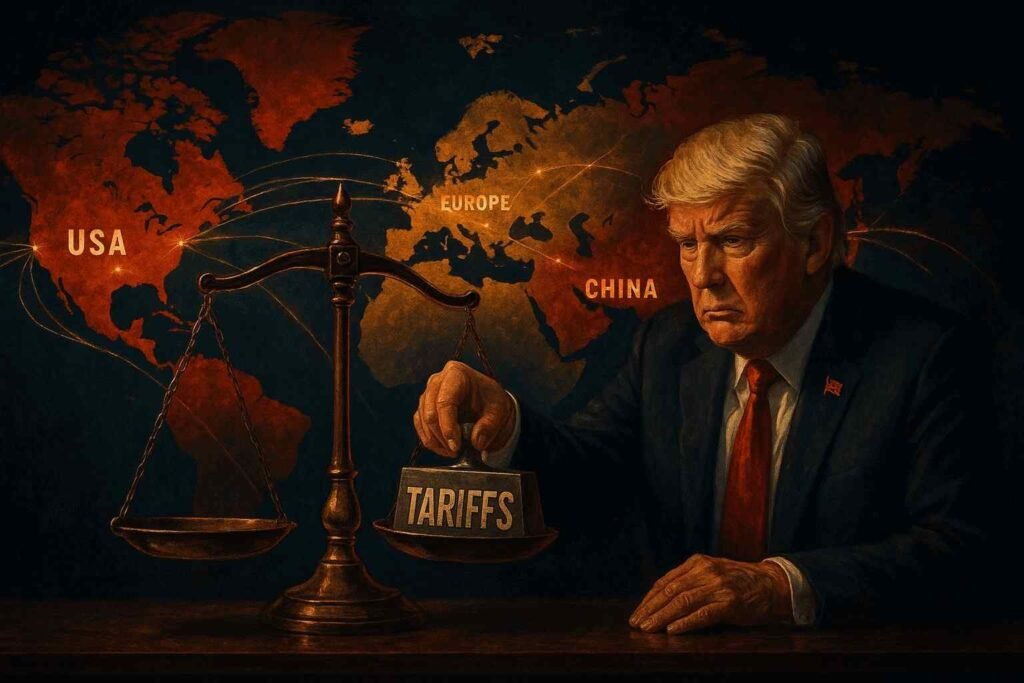
The morning I woke up to the news of Trump’s sweeping global tariffs, I immediately texted my brother-in-law who works in automotive supply chain management. “How bad is it going to be?” I asked. His response was blunt: “It’s worse than anyone’s saying publicly.”
Three weeks later, that assessment seems increasingly accurate. We’re witnessing nothing short of a fundamental reshaping of the global economic order that has defined international relations since the end of World War II. And unlike previous trade disputes, this one shows no signs of de-escalation.
The Tariff Tsunami: What’s Actually Happening
Let’s break down what’s actually happened since early April, because the pace of developments has been dizzying.
President Trump didn’t just target China this time around. He imposed what his administration calls “reciprocal tariffs” on virtually every trading partner of the United States. While all countries face a minimum 10% tariff, many face substantially higher rates:
- China: A staggering 54% (including previous tariffs)
- European Union: 20%
- Japan: 24%
- South Korea: 25%
- Taiwan: 32%
Even America’s closest allies weren’t spared. Canada and Mexico were hit with 25% tariffs back in February, ostensibly over border security and drug trafficking concerns.
I spoke with Maria, a small business owner in Chicago who imports handcrafted home goods. “I’ve built relationships with my suppliers in Mexico over 12 years,” she told me. “Now I’m being forced to choose between raising prices by 25% overnight or laying off three employees. There’s no third option.”
Beyond Economics: The Geopolitical Fallout
This isn’t just about prices at Walmart anymore. We’re witnessing a geopolitical realignment happening in real-time.
The reactions from global leaders have been unprecedented in their severity. French President Emmanuel Macron called for European countries to suspend investment in the United States. Polish Prime Minister Donald Tusk described the tariffs as “a severe and unpleasant blow, because it comes from the closest ally.”
Most concerning for American strategic interests, these tariffs have alienated key allies in Asia at precisely the moment when the U.S. has been working to build coalitions to counter China’s influence. South Korea, Japan, and Taiwan—all housing major U.S. military bases—were hit with punishing tariffs despite their critical role in American security architecture in the Pacific.
My college roommate, now working for a defense contractor in Seoul, messaged me last week: “The mood here has shifted dramatically. People are asking why they should host American troops while being treated as an economic adversary.”
The China Question: A New Cold War?
Perhaps most significant is how these tariffs are accelerating what many observers have called a “decoupling” between the U.S. and Chinese economies.
With cumulative tariffs now reaching as high as 104% on Chinese goods, and China retaliating with 84% duties on American imports, the world’s two largest economies appear to be constructing parallel economic spheres.
I asked Dr. Elaine Chen, an economist at the University of Chicago who specializes in U.S.-China relations, about the implications.
“What we’re seeing isn’t just a trade war anymore,” she explained over coffee last week. “It’s the beginning of a fundamental realignment of global supply chains into distinct blocs. Companies are being forced to choose sides in ways we haven’t seen since the Cold War.”
The data backs this up. Since Russia’s invasion of Ukraine in 2022, trade flows within blocs of geopolitically aligned countries have been growing 4% faster than trade between competing blocs. That trend is now accelerating dramatically.
The Domestic Impact: Are We Heading for Recession?
Beyond geopolitics, there’s growing concern about what these tariffs mean for American consumers and businesses already struggling with persistent inflation.
According to estimates from the Tax Foundation, these tariffs amount to an average tax increase of nearly $1,300 per U.S. household in 2025. Major retailers like Walmart have withdrawn earnings guidance due to uncertainty, while JP Morgan has raised its probability of a U.S. recession to 60%.
I visited a Target in suburban Detroit last weekend and noticed price tags being changed throughout the store. A store manager, who asked not to be named, confirmed they were implementing price increases on thousands of items.
“We’re trying to absorb some of the costs,” he said, “but there’s just no way around passing most of it on to customers. People are going to notice, especially families on tight budgets.”
Manufacturing workers, who were supposed to benefit from these protectionist policies, are instead facing layoffs as input costs rise and export markets close. Nissan has already paused production of two Mexico-built crossovers for the U.S. market, affecting hundreds of workers.
The Market Response: “Like a Problematic Emerging Market”
Perhaps most alarming has been the reaction in financial markets. Rather than strengthening American economic position, the tariffs triggered an immediate rise in U.S. borrowing costs as investors fled Treasury bonds.
Former Treasury Secretary Lawrence Summers noted that the U.S. is being treated by global markets “like a problematic emerging market,” reflecting a “generalized aversion to US assets.”
When I asked my friend who works at a hedge fund in New York about this reaction, she didn’t mince words: “Markets hate uncertainty, and what we’re seeing is the most uncertain trade environment in modern history. Nobody knows what sectors or countries might be targeted next, so risk is being repriced across the board.”
What Comes Next: Entrenchment or Resolution?
The big question now is whether this trade war will escalate further or if cooler heads will prevail.
So far, the signals from the White House suggest little appetite for compromise. Commerce Secretary Howard Lutnick stated bluntly that Trump “is not going to back off” the tariffs, describing them as “the reordering of global trade.”
Some countries are already seeking negotiations. South Africa has expressed interest in a new bilateral trade agreement, while British officials are working on a possible economic deal. Others, like the EU and China, have moved directly to retaliatory measures.
The reality is that we’ve entered uncharted territory. The post-WWII consensus around gradually reducing trade barriers and building an integrated global economy appears to be unraveling.
I asked a senior European diplomat (speaking on condition of anonymity) at a recent Washington dinner what he thought would happen next. His assessment was sobering.
“This isn’t just about economics anymore,” he said. “It’s about whether the international system we’ve built over 70 years can survive. The honest answer is: I don’t know.”
The Long View: A Fundamental Resetting of Global Relations
Whatever happens in the coming months, one thing seems certain: we’re witnessing a historic inflection point in how nations organize their economic and strategic relationships.
The idea that countries would automatically become more cooperative through economic integration—a core assumption of post-Cold War globalization—is being replaced by a more transactional and nationalist approach to international relations.
For ordinary people, this means more expensive goods, more volatile markets, and potentially fewer economic opportunities. For businesses, it means urgent reassessment of supply chains, investment plans, and market strategies.
And for the global order? It means we’re entering a new era where economic nationalism trumps multilateralism, where strategic competition drives trade policy, and where the institutions that have underpinned global stability for generations face their most serious challenge yet.
Looking to navigate your personal finances in these uncertain times? Live Chat Jobs connects qualified individuals with flexible remote positions that can provide stable income regardless of market turbulence. In times of economic uncertainty, having multiple income streams becomes more important than ever.
As I told my brother-in-law when we spoke again last night: “This isn’t just another news cycle. This is history happening in real-time.”
Find your perfect online opportunity today and build financial resilience as the global economic landscape continues to shift.
Whether you’re concerned about rising prices, job security in trade-dependent industries, or simply want the flexibility to work remotely as geopolitical tensions escalate, now is the time to explore your options.



